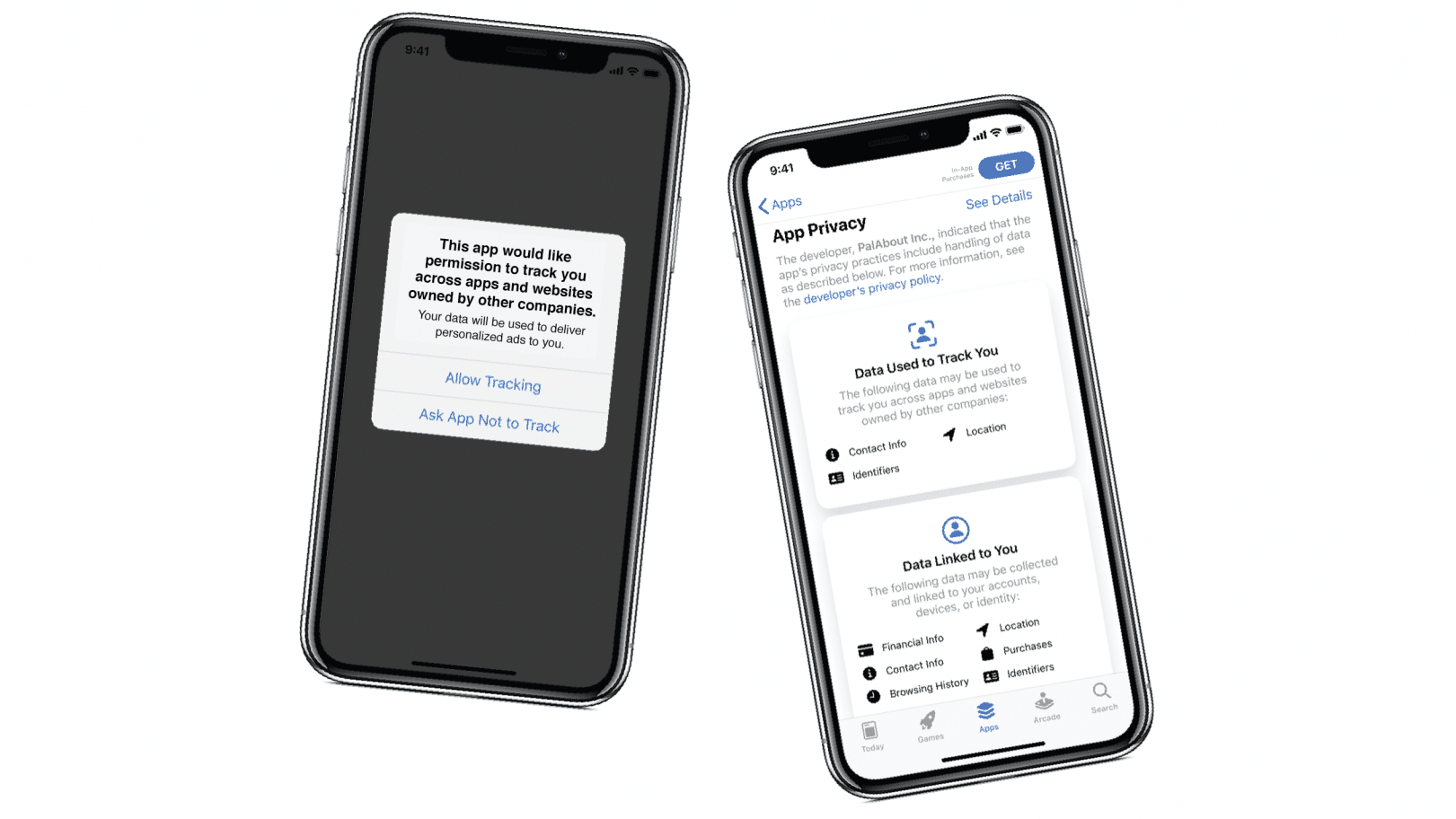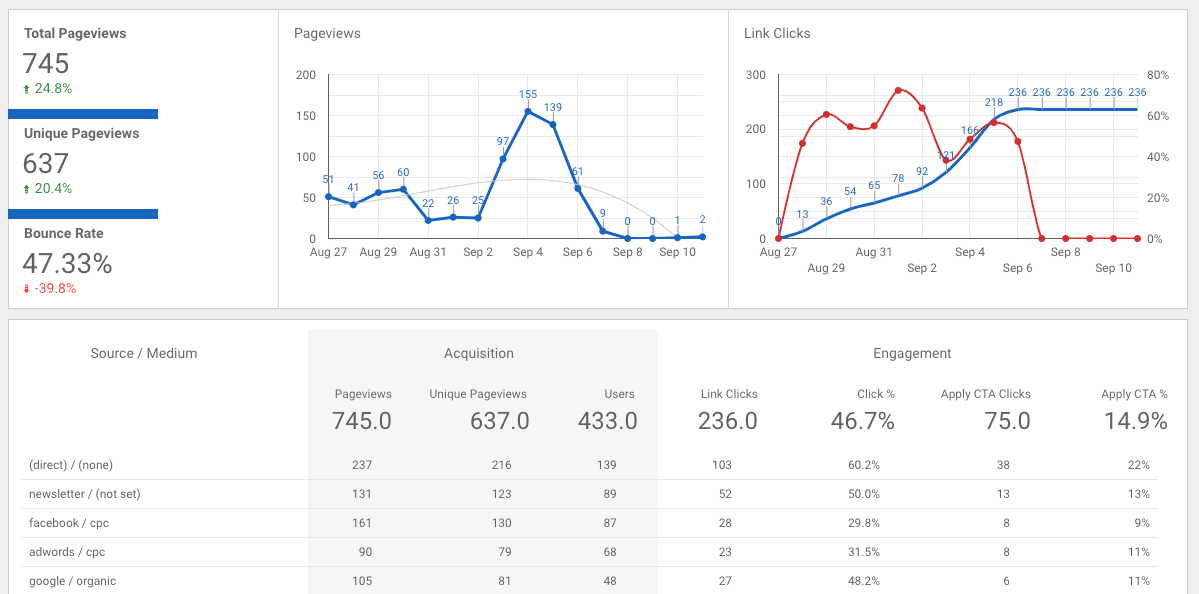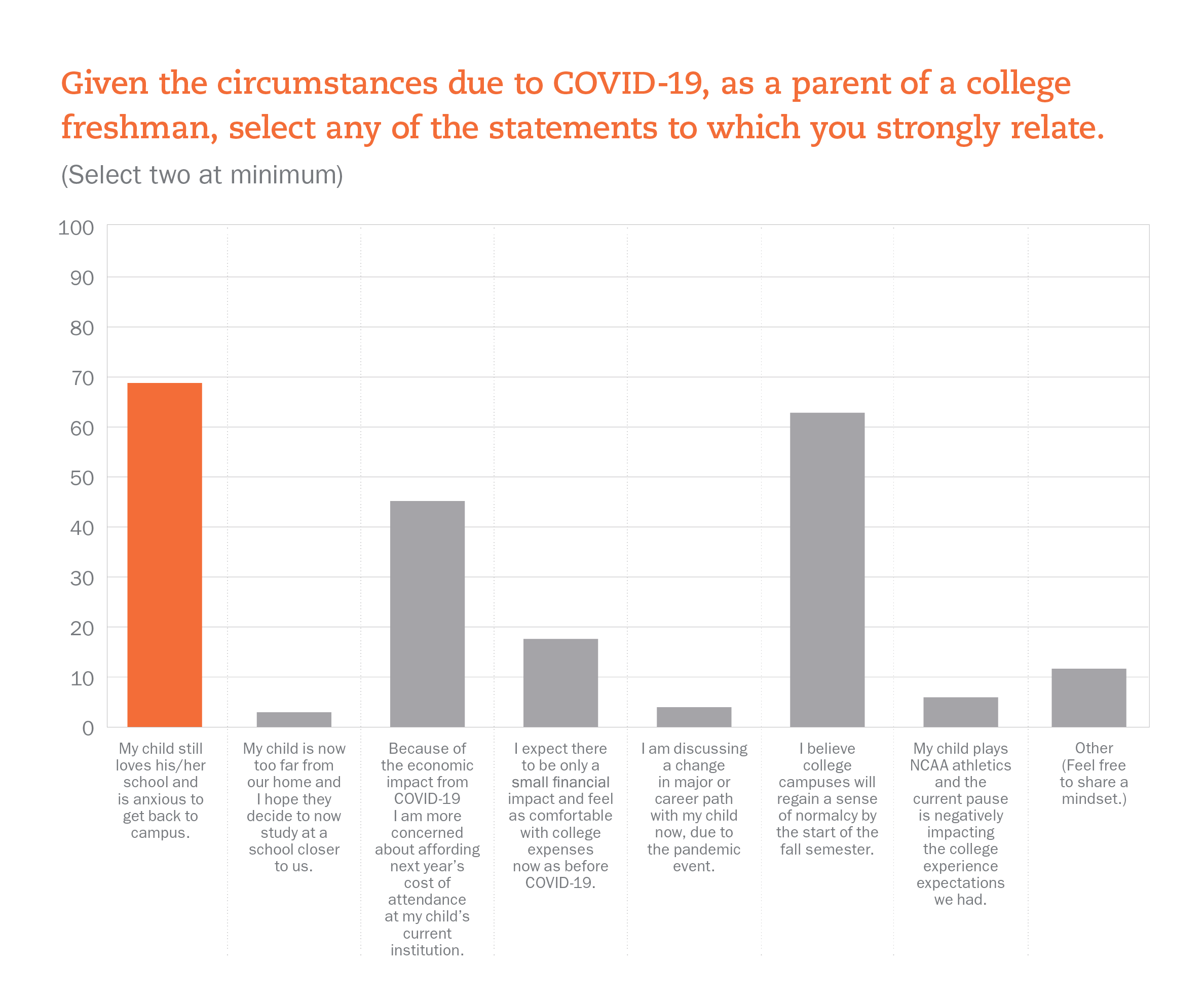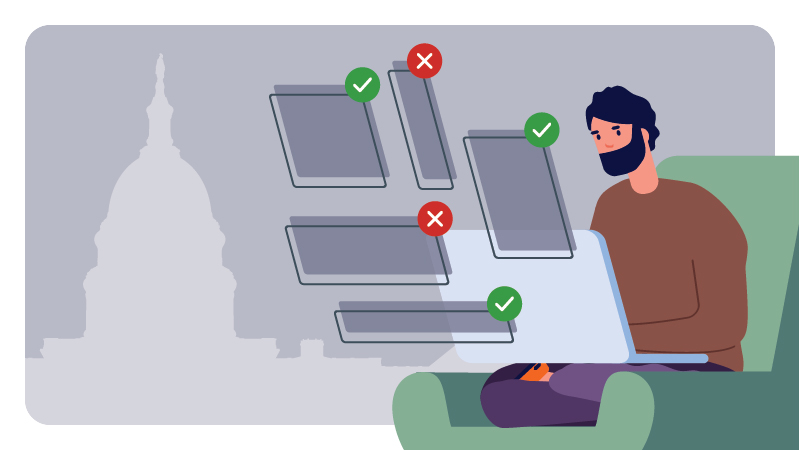Deliver a Powerful Virtual Commencement Experience
Graduation season is just about here! Even though we’re all grateful that national COVID-19 cases are finally dropping, you’re probably still feeling pressure to avoid a risky in-person event. Don’t worry—you can pull off an engaging virtual commencement experience, and we can help.
Spark451’s Virtual Commencement Support Package includes everything you need to deliver an event that is both memorable and special enough to satisfy your hard-working graduates and their families.
Check out the details, and then, reach out to discuss specific plans for your school!
The iOS 14 Update: How It May Impact Higher Ed
This spring, Apple is expected to release a significant update to the privacy settings on its iOS 14. The changes—which favor transparency for end-users over the targeting needs of marketers—could create significant hurdles for digital marketers in the higher education realm and beyond.
To help you understand how the forthcoming update may impact your campaigns, we’ll answer some of the key questions you’re probably asking yourself right about now.

So, What’s Happening With iOS 14?
With the new update, whenever users on iOS 14 launch a new app, they will now receive a prompt as part of Apple’s new App Tracking Transparency (ATT) feature that gives them a new type of control over who can access their data. The prompt will alert the user that their data may be collected, and they’ll be asked to choose whether they want to opt in or opt out of this tracking. This prompt will appear across all apps on iOS 14 devices, and we suspect that many tech-savvy users will opt out. (Until now, the default was to automatically opt in all users. In order to opt out, they had to know where to find the option in their settings.)
What Are the Ad Targeting Implications?
As an advertiser, it’s important to remember how much information these apps typically deliver about an individual’s circumstances and preferences. From web browsing history to TikTok videos watched and Facebook ads clicked, these apps track their users across the digital landscape, building demographic and psychographic profiles that can then be used in personalized ad targeting across digital platforms.
Basically, allowing users the ability to opt out of third-party tracking may limit the targeting personas we can build when we advertise. When it comes to Apple users, we’ll no longer have as robust targeting options available to use on platforms like Facebook, Instagram, or on display networks. This change won’t affect those who use Android phones, which are actually more popular worldwide than Apple devices. However, these changes may require digital marketers to get more creative in their targeting for Apple users. For example, in higher education, this may mean relying on alternative targeting strategies, such as creating lookalike audiences based on prior campaign conversion data.
What Else is Affected?
In addition to potential limitations in targeting, the new iOS will change the way we track conversions and report on them. Previously, Facebook utilized a 28-day conversion window and a seven-day view-through window, which means that a conversion could be counted within 28 days of a user clicking an ad or seven days of them seeing one. Now, however, Facebook is shifting to a seven-day conversion window for clicks and a one-day view-through window.
In terms of higher education, this may affect the numbers of conversions counted on select campaigns, as there’s a longer decision-making process within the vertical. For example, it may take a student a few weeks to take a high-value action, like beginning an application or making a deposit, and due to these changing rules, your Facebook ads may no longer receive credit for an action taken outside these conversion windows.
However, we don’t expect to see much change in our typical lead generation campaigns, as users usually take lower-stakes actions, such as inquiring, more quickly. In fact, based on our cumulative historical data, 99% of landing page inquiry submissions occur within the first seven days after the user has clicked an ad on Facebook or Instagram.
And What About the New Conversion Rules?
As if changing the conversion windows wasn’t enough, Facebook will also now require that ad domains are verified within your business manager account. This means each advertiser will have to have a verified domain in order to capture conversion actions, and if that domain isn’t verified, or if an advertiser tries to run ads to another unverified domain, those ads will not run. To ensure your domains are verified and that your ads can run, you may now require assistance from your web/IT team.
In combination with this change, Facebook is also implementing new conversion pixel policies. Previously, Facebook advertisers could track as many events (leads, clicks, applications, etc.) as they chose, but now, there will be a limit of eight per verified domain. Typically, in our higher education campaigns, we only use about three of these events, so this shouldn’t have a negative effect on our campaigns. However, it could pose an issue for institutions that utilize multiple digital vendors or that have different departments running and tracking campaigns at the same time. To help remedy this, Facebook will allow each verified domain to prioritize its eight conversion events. Though, if no action is applied, Facebook will default the ranking based on what they believe is the most relevant to your goals, based on your prior account activity.
How Can You Prepare?
It’s important to understand that these changes are occurring soon and to start strategizing the best ways to work around them. For example, any client utilizing UTM tracking and Google Analytics should be able to link conversions back to Facebook, even if they aren’t tracked within the platform. Additionally, if your CRM is able to capture UTM variables when a user submits a landing page, you’ll be able to effectively report on attribution even with the Facebook limitations in place.
Google will soon be implementing changes as well, as they prepare to end third-party cookie tracking. As these changes loom in the not-so-distant future, don’t hesitate to reach out, and keep an eye out for future blogs. Our digital advertising experts and seasoned enrollment strategists would be happy to help you navigate this new digital frontier.
Adapting Admitted Yield For A Virtual Era
Sure, the Super Bowl just passed, but if you’re like most admissions pros, you’re longing for our own big game: Admitted Students Day.
For most of us, ASD has always been the most critical day of the yield season. During those magical few hours, we’d welcome thousands of admitted students and their families on campus to razzle dazzle them and help them feel like they are truly a part of the campus community. Then—like clockwork—the deposits would start rolling in!
Though we’re optimistic about someday returning to those good old days, for now, things are different. Thanks to all the pandemic-related safety precautions, most of us cannot host a mass gathering anytime soon. Instead, we have to find multiple creative ways to help students make the same deep connections to your school and achieve the same enrollment results in a mostly virtual environment. To help you get started, here are several out-of-the box ideas that may help you get students excited to enroll at your institution.
1. Safer, Small Events

In the last year, admissions officers have learned how to develop incredibly successful virtual events—from visits, to info sessions, and more. However, Spark451’s original research shows that as many as 60% of students won’t make a decision to enroll without stepping foot on campus in person. So, if your local regulations allow, it would be wise to look for ways to complement those virtual events with smaller, in-person events so you can give certain students an in-person encounter in a relatively safe environment. For example, you may consider inviting 15 or 20 students to meet with select faculty members based on their academic interests, or create unique opportunities for students to connect with current students or hear from campus leadership. Think of it as an a la carte approach to ASD, and let families decide.
2. Seek Insights and Address Concerns in Real-Time

Even if you can’t be with students in person as much as you’d like, they still need to know that you’re always there to address their concerns. However, the distance can make it challenging to identify those concerns. Enter: the survey. This simple tool will allow you to quickly gather insights about which topics and issues are most interesting for individual students so you and your team can deliver personalized follow-up in a meaningful way.
We’d recommend sending one survey to admitted students, and another one to their parents, because each audience will likely have slightly different concerns. Based on the feedback, you might want to help a prospective student get in touch with a current student for more info about day-to-day life on campus, and you might find it makes the most sense to connect a parent with an advisor from the financial aid office.
You might even choose to survey guidance counselors as well, as a way of putting out feelers to see if they have students who could be a good fit for your institution.
3. Ramp Up Your Virtual Financial Aid Support

As you probably recall, the financial aid office was almost always the last group to shut down on Admitted Students Day. Their sessions were always packed, and they had lines of people waiting to connect with them after each one. If there’s one thing we can always count on, it’s that parents need help navigating the acronym-heavy world of FAFSA, CSS, EFC, ISR, and more.
In these uncertain times, it’s even more critical to help families understand the bottom line. Make sure to schedule a steady stream of virtual financial aid info sessions, Q&A sessions, and one-on-one meeting opportunities. Also, think about adding more easy-access resources to your website, such as informative videos and downloadable guides, so parents and students can access them whenever a question comes to mind.
4. Be Ever-Present

With so many parents juggling working from home, childcare, remote school, and more, it’s worth going above and beyond to make sure you’re there for them whenever they’re ready for you. Often, this will be outside of your regular business hours.
Since night and weekend events have never been more important, it may be worthwhile to get creative with how you schedule your team’s work time. For example, perhaps you can give your admissions counselors the option to take a day off in the middle of the week in exchange for running a live chat feature for admitted students in late evening hours. (When I say late, I mean like 11 p.m. to 1 a.m.—when parents finally get some time to think and those questions start bubbling up.) Thinking outside the box can help ensure you meet parents where they are, while also preventing burnout on your team.
5. Create a One-Stop-Shop Online

Even with the most creative scheduling tactics, it’s going to be hard to truly be there for prospective students 24/7, so it’s important to make sure that they can easily access critical resources online.
Create a one-stop-shop with everything they’ll need to know to enroll. Depending on your resources, you can either do this with a personalized microsite or by simply devoting a section of your school’s website. At the very least, be sure to include basic items like a checklist of next steps (enrollment deposit, FAFSA, orientation registration, housing and health forms, etc).
To deepen student engagement, take it a few steps further. Include residence hall room dimensions so students can start planning their packing lists. Add some content on dining hall favorites (“Don’t miss chicken parm Thursdays!”) so they can start picturing themselves on campus. Start developing team spirit by adding some game-day essentials, like the lyrics to your team’s fight song and victory song. You could even connect with your IT department to set up live cams across campus so students can get a true sense of campus life in the spring. The options are endless.
6. Boost Digital Engagement Opportunities

Social media is always a great way to reach students where they are. In addition to running paid campaigns designed to boost engagement among your admitted student pool, you should also make an extra effort to post organic content that will encourage them to pay attention. Try asking your admissions counselors or tour guides to share some anecdotes or interesting campus shots to liven up your posts.
Pay special attention to platforms such as Instagram, Snapchat, and TikTok. All three make it possible to share interesting animated content that students can comfortably explore in a non-invasive manner, as the posts won’t necessarily require a specific call to action. Think of these posts as a way to enhance overall brand awareness of your institution in a positive, controlled way.
7. Swag with a Purpose

Who doesn’t love a freebie? Since you’re no longer spending money on large campus events, spring recruitment travel, and other traditional yield expenses, consider repurposing some of that budget to develop some promo items that can help foster stronger connections to your school. For example, a celebratory yard sign can be a great way to help make a student and their family feel special, and it gives them a fun way to share their big college decision news with their friends and neighbors!
Final Thoughts
It’s important to remember that all of these efforts are best complemented by a strong admitted yield communications program, with targeted messaging designed to strengthen affinity and nurture students through the process from acceptance to enrollment.
I hope these suggestions have helped to spark some creative ideas of your own. If you need additional help planning out the rest of your yield season, please don’t hesitate to reach out. My colleagues and I are always here to help you determine the best tactics for your institution. We’re rooting for you!
Higher Ed Web Trends for 2021
The web has long been the number one resource for students seeking information about a college. In 2020, this fact became more pronounced than ever, with students compelled to use the web to replace in-person visits, information sessions, and general fact gathering in their college search processes. The web took center stage as the virtual home for admissions.
As Spark451’s design group, we constantly reflect upon the essentials for successful university websites that are prospective-student focused. There is so much to consider when managing a website, and you can’t skimp on anything. From responsive design to SEO, and content strategy to accessibility, it all matters. As the COVID-19 pandemic hit, colleges and universities were forced to think differently about how they engage with prospective and current students in the digital space. It is in this spirit that we are offering this overview of key higher ed web trends you should be aware of in 2021. Our aim is to prepare you for the unexpected, and to help ensure that users anywhere and of any background can rely on you to give them the information they need to make a great college choice.
Trend 1
Drag-and-Drop Builders
Across the web, more visual and intuitive ways of creating content have become increasingly popular. With the WordPress 5.0 release in early 2019 came a block editor called Gutenberg that completely changed the website editor experience. The technology was slow to be adopted, but in 2020, it went mainstream with a new release and a more robust library of components. Thanks to this drag-and-drop page builder, the building experience is more user-friendly than ever. It offers content managers the opportunity to build their websites without expert knowledge of coding. A version of Gutenberg was also ported to Drupal to compete with the native (and less flexible) Layout Builder within Drupal 8.
How does Gutenberg work? All the content is divided up into individual “blocks.” Gutenberg has many different types of blocks, such as headers, quotes, lists, galleries, and so on. Add-ons like ACF Blocks Suite offer a comprehensive collection of ready-to-use Gutenberg Blocks to help you make a beautiful website.

When you’re faced with unexpected changes or having to add completely new sections of content, a drag-and-drop builder is an easy, visual solution to get your pages up and running in no time. And while we won’t be getting rid of field-based content management any time soon, drag-and-drop builders let us create media-rich landing pages with speed and ease.
Trend 2
Content Is Still King
Users come to your site for a reason: the content! And when it comes to managing that content, you need a strategy. In the COVID era, we shifted our focus to bring events online and create compelling content for live interaction. Many of us even became broadcasters for the first time, mixing live video streams with slides and films into our Zoom meetings and webinars to get our messages across. And if you haven’t done that, you certainly will need to for the better part of 2021.
Another major content trend for the year ahead is the repurposing of existing video content to create new interpretations for shorter snippets and social stories.
And of course, many of you discovered that your site wasn’t as easy to use as it could be, so you had to rewrite and reconfigure your admissions section to be more usable and reader-friendly. (We often use tools like the Hemingway Editor to write more accessible, readable copy that aligns with a ninth-grade reading level.)
Finally, web personalization is becoming even more important in 2021 as students look for colleges that have their needs and interests in mind. We build personalized microsites to help admissions offices build even greater connections to students.
Trend 3
The Need for Speed
In many ways, web design is a balancing act. You want to have beautiful pages with compelling video, breathtaking images, and sophisticated typography, but you also need to ensure the pages load quickly.
In mid-2018, Google began to roll out a “speed ranking” for both mobile and desktop searches. In essence, if your pages were not fast, your page would not rank high on Google searches. This is an existential threat for colleges that rely on Google for up to 80% of their inbound traffic. (To check your site’s speed, go ahead and fire up the Google Lighthouse tools.)
Of course, prioritizing speed isn’t just about Google rankings. If your page doesn’t load quickly, the viewer will act fast and move on. The average human attention span dropped from 12 seconds to eight seconds in 2018, so we have to keep those load times short!
12 SECONDS
The average attention span of a human in 2000
8 SECONDS
The average attention span of a human NOW
Erik Runyon of Notre Dame did us the favor of analyzing the fastest home pages in higher ed. How does your site stack up?
Trend 4
Design Innovation
Web designers are always innovating, bringing novel content structures and components to your pages to elevate the experience for prospective students. Here are a couple we think are important for 2021:
Parallax Scroll Animations – These keep your page dynamic, layered, and engaging, and they’re so simple! Nobody wants to read a wall of text, so mixing in some images helps divide up content and provides some visual interest.
Secondary Navigation: Menu Takeover – Less is more, as they say. The less “clutter” you see in your primary navigation, the better. This menu takeover gives you the opportunity to decrease primary navigation clutter and create an engaging, interactive navigation experience.

Negative Space Is Actually Positive – OK, this isn’t really new, but it’s worth repeating. Adding negative space to your designs highlights your newly finessed content so that it is easier to read and understand.
Trend 5
SEO Awareness
If you build an amazing website, but its content doesn’t show up on search engines for important keywords, does it really exist? How can I show up for searches that don’t include my college’s name? These are the questions you will need to answer in 2021, as competition heats up to capture the attention of people who are searching online for undergraduate and graduate education opportunities.
SEO is yet another example of the web design balancing act. We want to give our writers the freedom to use their talents to best express our spirit and quality, but we also have to ensure that what they write can also be appreciated by Google’s web crawlers and machine learning algorithms. It starts with “technical SEO,” which means getting everything right in our code—from semantic elements to proper meta data structure—and extends into the content manager’s domain.
Keyword research helps us understand the words we need to target, and comprehensive knowledge of web standards helps us use those keywords with the proper emphasis for the search engines. (For example, be sure to use your most important keyword in the <title> tags and <h1> tags.) SEO is an expert’s game that can be learned, and we are here to help for those in need.
Trend 6
Power to the Pixels: Conversions, Retargeting, and Tracking
With recruitment and registering online becoming the norm, the ways in which we keep track of those interested users must change. You want to know when someone visits your website and how they interact with it. Maybe they’re interested in learning about your institution or the nursing degree you’re well known for, or perhaps they came to learn about an event you’re hosting that was shared on social media. In these cases, you want to be able to follow up with those visits and clicks to make sure users are getting the information they need and seeing what makes your institution stand out from the rest. That’s where pixels come in.
A pixel is a tiny, invisible digital marker that is placed on your website in order to keep track of a user’s movements throughout. Not only can it tell you how they got to your site in the first place, but it can tell you:
- The time of day they visited your website
- Their locations
- New or recurring visits
- What browser they used
- The type of device they used (desktop or mobile)
- And more…

With this type of information, you can learn more about what your users are interested in and make smarter marketing decisions. Ultimately, you’ll take these learnings to optimize your digital ad spending so you can avoid focusing on ineffective marketing campaigns.
Trend Imperative 7
Accessibility
We anchor this blog post with the topics of accessibility because, without it, nothing else matters. It is not a trend, per se, but a responsibility and, doggone it, it’s the right thing to do! Equity and access are part of our national discussion on higher education and those ideas reflect the foundational values of our colleges and universities. Everyone belongs on our campuses, and everyone deserves to be able to access our content. Of course, these values are codified into law in Section 508 of Rehabilitation Act, which states that any entity that receives funding from the federal or state government must meet WCAG 2.0 AA accessibility standards.
According to w3.org, “web accessibility means that websites, tools, and technologies are designed and developed so that people with disabilities can use them.” Many colleges have been slow on the uptake of accessibility, but are catching up in 2021 and beyond. Part of the reason accessibility has been tough for designers is that it requires some tradeoffs that may be difficult to follow. For example, some schools have had to use a different shade of their school colors to increase contrast (for color-blind readers), or cut back their use of JavaScript widgets that just can’t be navigated through voice.
At Spark451, we have redoubled our efforts in accessibility, standardizing our approach around the Axe Accessibility testing tools, and adding screen readers and keyboard navigation to our testing process.
In Closing
2020 was a disaster in many respects, but certainly not for higher ed websites, which stepped into the spotlight as the indispensable tools that they are. We wish you the best of luck in using your website to serve your student populations in realizing their higher education goals. And if you should find yourself in need of a web design partner, you know where to find us.
Webinar: Understanding Your Institution’s Whole Brand
If you’ve ever wished you had a better way to uncover and analyze everything that’s said about your institution when you’re not around, check out our latest webinar.
Together with our new partner, Feedback (an ethnographic research agency), we discuss:
- How the intersection of persona modeling with ethnographic research and “social listening” provides a more holistic approach to marketing
- How to identify and analyze brand perceptions
- How to understand whole-community behavior
- How your target audiences make decisions
- And more!
Webinar: COVID + College Search: What HS Seniors Are Saying Right Now
We all recognize that this admissions cycle is unlike any other. Regardless of how well your school is doing in terms of applications, you need current information to stay on track and plan for the coming months. That’s why Spark451’s Education Research Division surveyed high school students in December 2020. Earlier this month, we proudly shared the hot-off-the-presses results during a 60-minute webinar.
Check out the webinar recording to learn:
- What students say about where they are in the college application process
- How COVID has impacted their plans
- How you can best position your institution in the coming months
You can also download the full presentation!
The Great Ad Pause: Why it Matters for Higher Ed
The Google political ad ban began once again yesterday, January 14th. Just like in November 2020, when media giants Facebook and Google both implemented political ad bans to prevent misinformation about the election from spreading, Google has now implemented an additional political ad ban in the week leading up to Inauguration Day. Meanwhile, aside from a brief lift in Georgia for their Senate runoffs earlier this month, Facebook has kept its political ad ban in place since election week.
As a budget-conscious admissions professional, you may be wondering, what does all of this mean for our higher education digital marketing efforts? In general, as we look back to early November, it doesn’t seem like the political pause significantly impacted digital media ad performance for our college and university partners, but we can still glean some valuable insights when we look closely. After all, according to Google’s own disclosure of ad spend from 2018–2020 in the political vertical, between May 31, 2018 and today, there have been a total of 563,267 political ads served across the Google network—which includes giants like Google Display Network, DV360, and YouTube—with a total spend of over $745 million. Talk about influence!
Here, we’ll share a couple observations about how some of our partners’ ads performed during the last ban, and then, we’ll offer some advice to help you navigate your own digital media plans during the next few weeks.
Ad Performance Highlights
Looking back to November 2020, when paid media networks paused political ads, our clients kept running ads because it was both a pivotal point in senior search season and a prime time for graduate search to take off.
13%
increase in impressions during Election Week
12%
increase in clicks during Election Week
In one noteworthy example, a partner school who is our biggest daily spender in paid media, and mainly does targeted ads, saw a 13% increase in impressions and 12% increase in clicks during election week, compared to the week prior. However, the school’s cost per lead also increased significantly week over week, and there were fewer conversions.
Meanwhile, one of our biggest college brands—a nationally recognized university in Virginia—ran an apply campaign that week targeting a large list of prospects (read: a limited and defined audience, but still a very large group). They saw lower clicks, lower conversions, and a higher cost per click, compared to the previous week.
Looking Ahead
While the individual examples above have varying budgets and audiences, when we look at the performance of all our paid media accounts during election season, one thing becomes clear: Reach and impressions saw a slight lift due to less ad spend from the pause. However, overall, the pausing of political ads didn’t have a significant impact on higher education search efforts on digital back in November—and it likely won’t this time, either. Considering this, we advise our partners not to shy away from paid media campaigns in the next few weeks; prospective students are still using digital avenues to stay connected to their networks, and they’re continuing to engage with paid content.
Under normal circumstances, January, as well as the majority of Q1, tends to be a great time to run higher education ads for many reasons, but of course, this year it is even more important to get in front of your digitally focused prospects. In fact, we’re seeing the shift to more digital marketing for higher education firsthand. At Spark451, Q1 2021 is already up by 28% in planned or currently running paid digital media campaigns, compared to Q1 2020. Plus, after the year we all had in 2020, it’s no surprise to us that emotional marketing for a fresh start may be more impactful than ever before.
Meet Feedback, Spark451’s Newest Strategic Partner
Jeff Bezos once said, “your brand is what other people say about you when you’re not in the room.” At Spark451, we’ve spent nearly a decade helping college and university admissions pros like yourself use surveys, focus groups, and other data to craft marketing campaigns that promote your institution’s true strengths and overcome any misperceptions. Now, we’re about to take it a step further through a new partnership with Feedback, a Richmond, Virginia-based agency whose hand-trained data scientists and behaviorists offer voice-of-the-customer ethnographic research and analysis about how people perceive your brand. These fresh insights will allow us to provide you with a new level of data-driven marketing strategies and messaging that truly resonate with your target audiences.
Key institutional benefits will include:
- Exploring how audiences make decisions
- Identifying and analyzing brand perceptions
- Competitor profiles and brand sentiment
- Channel and influencer identification
- Understanding whole-community behavior and best practices
“This exciting addition of Feedback’s unique brand of social listening and real human analysis is a perfect match for Spark451’s hyper-personalized approach to persona modeling, lead generation, and brand awareness campaigns,” says Pete Colbert, Senior Business Development Strategist at Spark451. “While we’ve always taken a data-driven approach to marketing for higher education, the additional insights we’ll receive from Feedback will expand our perspective and further enrich our strategic planning, allowing us to develop even more effective campaigns for our college and university partners.”
“While surveys and focus groups showcase how your many audiences (from the prospective student to the friend of the college) speak when prompted, our digital ethnographic approach using actual behaviorists to analyze how discreet audiences discuss, ask, respond, interact, and simply behave in all corners of the internet helps build a more complete picture,” adds Feedback Principal Dean Browell, PhD. “We’re excited to bring more of our solutions to higher education by formally expanding our great relationship with Spark451.”
Watch Our Webinar
Check out Spark451 and Feedback’s webinar, “Understanding Your Institution’s Whole Brand: How Better Listening Enables More Impactful Marketing Campaigns,” to get more details about how a unified branding model for enrollment marketing, utilizing both persona modeling and ethnographic research, can yield incredible results for higher education institutions like yours.
Silver Linings Playbook: 2020 In Review
When I sat down to write this, I typed and deleted so many clichés about the kind of year we’ve had. Since you’ve also lived through 2020, you already know how “unprecedented” it is, so I’ll assume you won’t mind if we skip that part.
Now, for the real reason I’m here: I just don’t think it’s especially healthy to head into a new year without pausing to appreciate some of the good things that have happened in 2020—and there HAVE been some good things. (Even a few that should benefit the higher ed field for years to come.) So, in an effort to get us all in a positive frame of mind and motivated to tackle the new year with enthusiasm, I thought I would highlight a few silver linings that have resulted from the major events of 2020.
Silver Lining 1
Colleges and Universities Learned How To Be Nimble

Dare I say that higher education is infamously glacial? Well, it’s true. Our institutions each have a wide breadth of processes, procedures, programs, and regulations that tend to make us about as agile as a large oil tanker at sea.
However, when push came to shove this year, your institution’s faculty and staff made herculean efforts and demonstrated the ability to be nimble in an environment that required such speed and institutional agility. You have so much to be proud of.
First, you and your colleagues salvaged the Spring 2020 semester by rapidly and safely closing campuses across the country and disseminating critical information to students, families, and the community. During that period, I spoke with presidents at a few schools who were proud of the fact that they could make swift decisions that directly benefited their students’ health.
Second, your team still enrolled a new student class for the fall. You shifted very important on-campus events, like admitted student days, to virtual environments. You also worked to ensure applicants and their families had their questions answered and could find a place they would call home for the next four years.
Third, your colleagues figured out ways to work together and safely kick off the fall semester by introducing concepts such as hybrid environments, quarantine spaces, mask policies, and more.
These are lessons that you will carry with you for your professional life. Plus, now we’ve learned that higher ed can be just as nimble of an environment as as a tech startup…OK, maybe that’s a stretch, but you definitely moved from an oil tanker to a schooner. Congratulations!
Silver Lining 2
Higher Education Advanced in Online Delivery of Academic Coursework

For this silver lining, I reflect on a discussion I had earlier this year with a vice president at a major public institution/system in the northeast. She relayed to me the story that just a few years ago, as they were upgrading the connectivity throughout campus, the administration wanted to install webcams in classrooms for future use. At that time, the faculty union filed a grievance stating that doing so would undermine their ability to protect the privacy of their intellectual property, the academic coursework. They won that grievance.
Yet, just a few years later, your institutions were literally placed in a do-or-die academic situation and everyone involved rose nicely to the challenge. Before this year, some faculty had never actually used a Zoom, Teams, or Meets environment, but they dug in and found a way. And in an incredibly short time, they gave new credibility to the online delivery of academic coursework.
I like to keep things real and recognize that, in some cases, it was less than ideal—maybe even impossible. Some classes require labs or other in-person experiences, like clinicals and student-teaching, that are invaluable to achieving a successful program. Yet, still, for the vast majority of undergraduate programs, 2020 is a true milestone year for the online delivery of academic content.
(As a side note, for those of you who are in geographic areas where snowfall can happen, I think we just witnessed the end of snow days as we know them for all students from middle school through college. Academic evolution is happening right in front of our eyes.)
Silver Lining 3
Colleges and Universities Learned That Their Campuses are Important

If there is one message that came out of 2020 and the COVID pandemic, it is that the public truly values the student experience your campus provides and that many students want to be on your campuses–even if that means attending classes virtually. And the majority of your campuses delivered on that experience with safety and support in force.
In the late spring, we surveyed the parents of freshman students and asked them how they felt about their students returning to school in the fall. Here’s what they had to say:

You may think this applies exclusively to undergraduate students and programs, but an even more recent survey of domestic graduate intenders also demonstrated a continued preference for in-person learning:

Silver Lining 4
We No Longer Take Our In-Person, Professional Conferences For Granted

As professionals in college admissions, we have had the great opportunity to develop our own skills, connect with friends, and network with new colleagues through a wealth of professional conferences. They range from regional groups to national conferences and cover every aspect of our professional lives. Honestly, as a person who attended my first conference in 1991, it became easy to take these conferences for granted, and I sometimes considered attending them a borderline chore as opposed to a phenomenal opportunity.
Yet 2020 (and possibly 2021) took those precious opportunities away from us. Sure, we have all made an effort to make the best of the situation by participating or presenting in virtual conferences. However, much like students who prefer being on campus, we realize that the in-person experience of being with an incredibly talented group of people for a few days to learn from each other is truly irreplaceable.
My hope for 2021 is that we get to a place where we feel it’s safe to meet, interact, and enjoy each other’s company in person.
Looking Ahead
On behalf of all of us at Spark451, I’d like to wish you all the safest and happiest of holidays as we wrap up 2020. Stay tuned as we continue providing fresh perspectives, original research, and direct guidance through our blog series in 2021.
Meeting Graduate School Intenders Where They Are
By Ed Flaherty and Meryl McDonough
2020 has brought tidal-wave-sized shifts to higher education. While virtual events, test-optional policies, and COVID closures have dominated the admissions workday, a new player has quietly entered the graduate school arena—the first wave of Generation Z students.
That’s right: The eldest Gen Z students are now about 23 years old, and they’re making their way into the workforce and graduate programs. The question is: Are your graduate marketing efforts primed to reach this new breed of prospective students?
Gen Z: What We Know
You’ve heard about them. You’ve likely done your own research on them (and if not, there are countless resources available if you need to get up to speed). In fact, our 2020 Graduate School Intenders Survey found that:
- Email and text messages are their preferred direct channels of communication
- Most of these students spend more than three hours a day on social media
- Google is the most used resource in their search for graduate programs
Cultivating Leads
As our survey confirmed, Gen Z is a “just-Google-it” generation who will never know the pain of scouring a library full of encyclopedias to find an answer, waiting on a dial-up connection, or the primitive experience of an “AOL keyword search.”
To reach this audience where they are, it’s crucial to run digital media campaigns that use Google Search Ads (formerly AdWords) paired with an engaging landing page. Google Ads allow you to deliver content that directly relates to what these students are searching for. For example, an ad for your Master of Business Administration program can be there when a prospective student searches Google for the “best MBA program.” Similarly, you can deliver an ad for your Master’s of Education program to those searching for answers to questions like “How do I become a teacher?”
Appearing at the top of their search with a succinct, engaging value proposition can earn you clicks and new leads from those eager to learn more about your program. Plus, our team of digital marketing experts can help you get the most out of each Google Ads campaign by continuously optimizing your ads and their paired landing pages.

Lead-Nurture Tactics
Once you pull these students into your funnel, you’ll need to deliver a steady stream of relevant messaging in order to keep them engaged, and ultimately, drive them to apply and enroll. Spark451 has been perfecting outreach methods to Gen Z for years with great success. We’ve built key strategies that meet this generation where they are — online and mobile. Our secret recipe for success isn’t all that secretive:
- Hyper-personalized, segmented, and captivating e-communications
- Robust, personalized text messaging
- An extensive digital media strategy implemented across targeted social platforms
Each of these “ingredients” is, of course, created with mobile-friendly design and accessibility in mind.
Get Ready for GenZ
Now is the time to make sure your recruitment efforts are optimized to reach the latest generation of grad students, and the experts at Spark451 can help you do just that. We’d love to discuss your institution’s specific challenges and help you determine which strategies and tactics will best prepare you for your next cycle. Reach out so we can get started.









